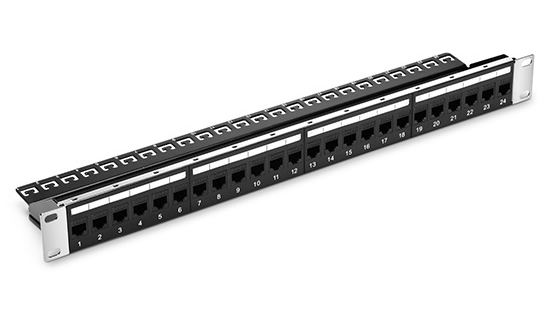What Is A Network Patch Panel? Why Use It? How to Buy It?
Now we often need to deal with lots of cables when building up networks for data centers, offices, or homes. And it is best practice to use network patch panels for connecting these cables to various networking devices. However, there are still people who think this is redundant, unaware of the benefits of a network patch panel. Therefore here will have a thorough introduction to the network patch panel and its benefits, and give some tips on buying the best network patch panels.
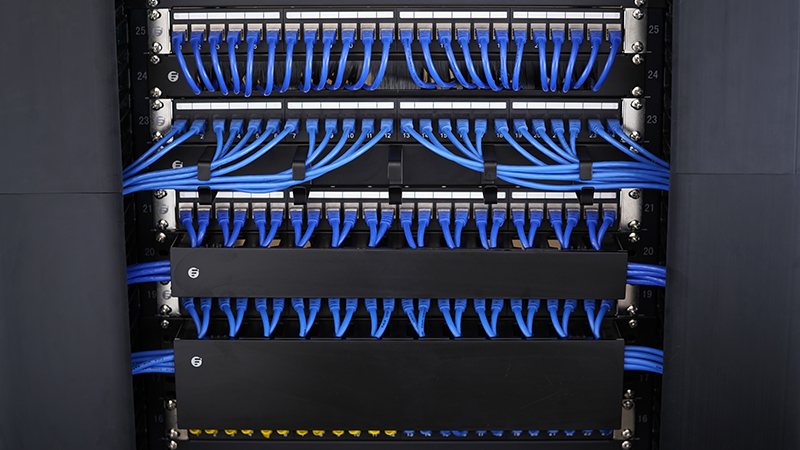
What Is A Network Patch Panel?
The network patch panel is a passive mounted hardware assembly with multiple ports to connect and manage input and output cables that need to be connected to the networking hardware. It is usually attached to network racks, either above or below network switches or servers. Now there are many types of network patch panels designed for various applications. For example, there are Cat5e, Cat6, Cat6a, and Cat7 Ethernet patch panels for specific cable specifications. While according to the number of ports, 12-port, 24-port, and 48-port patch panels are also available. In addition, there are also unshielded and shielded patch panels, punch-down and feed-through patch panels.
Why Use A Network Patch Panel?
As mentioned above, a network patch panel servers as a static switchboard which connects numerous devices to a central server, switch or other critical hardware. If we don’t use it, we’ll have to run Ethernet cables from each device directly into the central hardware. Moreover, every time we want to reconfigure the network or cabling for more devices, it will be difficult for us to find out the right cables, unplug them and connect them to the new devices. Besides, network patch panels also benefit us a lot in the following aspects:
With network patch panels, all Ethernet cables can go into one central cabling location. This helps to keep the cabling system tidy and organized, avoiding cables from becoming tangled and messy. In addition, patch panels’ ports are often labeled, which allows us to better identify which cable comes from where.
Since all cables are terminated on the network patch panel, the switch or server won’t be disturbed when small changes are made with the cabling. Furthermore, these changes can be made easily and quickly. As for troubleshooting, the clearly labeled ports make it easier to locate cables which need to be tested or replaced.
As we all know, there is a risk of damaging the surrounding cables when adding or removing a networking hardware. However, the usage of network patch panels can greatly reduce the risk of unplanned outages by making it easy to add and remove cables without touching the main hardware.
How to Buy A Network Patch Panel?
When buying a network patch panel in the market, you’ll find there are many options in terms of styles, cable types, number of ports, etc. It’s easy task to decide which cable type you use and how many ports you need for your cabling. However, you’d better be careful in choosing between network patch panels for home and patch panels for enterprise network or data center.
If you want to buy a network patch panel for home or small office, an unshielded Cat5e or Cat6 patch panel with 12 or 24 ports is often enough. And for most home users, they often choose the punch-down panel rather than a feed-through one for its cheaper price. If you buy a punch-down one, you’ll need to wire the patch panel by yourselves. Further more, wall-mounted network patch panels are also popular for home networks. For enterprise network or data center users, it’s better to use rack mounted shielded 48 port Cat6a or Cat7 patch panels. And the feed-through ones are also suggested. For more information on buying punch-down or feed-through panels, read Should We Choose Punch-Down or Feed-through Patch Panel?
Source: http://www.fiber-optic-transceiver-module.com/network-patch-panel-wiki-why-use-it-how-to-buy-it.html
When to Use Gigabit Ethernet Switch for Home Networks?
As one part of the Ethernet family, Gigabit Ethernet is now inexpensive and ubiquitous enough for home networks. Thus many people plan to buy the Gigabit Ethernet switch for upgrading their wired home and small office networks. It is true that we will benefit from Gigabit Ethernet switches since they provide 1000Mbps data rate theoretically. But do you really know or need a Gigabit Ethernet switch? Are your home network devices ready for upgrading to Gigabit Internet?
What Is A Gigabit Ethernet Switch for Home Network?
Like the other Ethernet switches, the Gigabit Ethernet switch is responsible for directing the bandwidth of your network connection to different home network wired devices such as computers. However, it can support 10, 100 and 1000Mbps data rate, which improves the reliability and functionality of a home network. For example, you may see better performance from your 4K streaming device or gaming system by connecting them to a Gigabit Ethernet switch. Now there are often 5-port, 8-port, 24-port and even 48-port Gigabit Ethernet switches in the market. While the commonly used ones are 8-port and 24-port switches. In addition, there are also managed and unmanaged, PoE and Non-PoE types. For home users who need a IP camera system, it’s better choice to buy a managed Gigabit Ethernet switch with PoE function.

When to Use A Gigabit Ethernet Switch for Home Network?
Before upgrading your home network to Gigabit Ethernet, you should know when it can offer a benefit and when it can't. Not all network operations will benefit from Gigabit Ethernet. For example, Gigabit Ethernet won’t speed up things like Web browsing or the uploading and downloading of files from the Internet. This is because those activities are limited by the speed of your broadband connection. However, if there are multiple users accessing the same network device, Gigabit Ethernet will provide more total bandwidth to go around, which in turn result in less congestion and better overall performance. In addition, Gigabit Ethernet is also helpful when large file transfers are involved, like when you perform backups over the network to a server.
If you decide to deploy the Gigabit Ethernet, there is another thing to consider - buying a Gigabit Ethernet switch or Gigabit router. Generally, home Gigabit routers usually come with three or four Gigabit Ethernet ports built in. And most devices in a home network can support Wi-Fi. Therefore, most people don’t really need the switch. But a Gigabit Ethernet switch is essential when you don’t have enough Gigabit Ethernet ports for wired devices. Moreover, if you prefer to use wires for faster speed or plan to install Gigabit Ethernet ports in your home wall, a Gigabit Ethernet switch is also a better idea.
Home Network Gigabit Ethernet Switch FAQ
First of all, you need to make sure your home devices can support Gigabit Ethernet. However, there is a good chance that your devices already support it because Gigabit Ethernet capability has been standard fare on desktops and other devices for years. Second, it is suggested to use Cat5e or Cat6 cabling for Gigabit Ethernet. So if you use Cat5 cables now, you’d better replace them. Though this may be troublesome, it is desirable in the long run. The last thing is to buy a Gigabit Ethernet switch best for your needs.
Sure you will need. Though the switch and router perform some similar functions, they each has its own function. The Gigabit Ethernet Switch can not connect to the Internet by itself. In other words, it needs a router to connect to the Internet. The mission of a Gigabit Ethernet Switch is to extend home network capacity.
A best Gigabit Ethernet switch here means it meets all your needs and the price is good. As mentioned above, the Gigabit Ethernet switch can be divided into managed and unmanaged, PoE and Non-PoE types with 5/8/16/24/48 ports. Unmanaged switches are plug-and-play, while the managed ones allow you to change network settings and other functions. Gigabit PoE switches are designed for home IP camera systems, or for situations where there is no power source for PoE enabled devices. As to the switch ports, you’d better choose one meets both your current and future growth needs.
Originally published at Gigabit Ethernet Switch: Is It Needed for Your Home Network?
Cloud Computing vs Grid Computing
For starters, both cloud computing and grid computing are used to provide services through sharing capabilities and resources. And they are very similar concepts which can be easily confused. However, there are some key differences that can distinguish them properly. Here we will talk about cloud computing vs grid computing key differences and help you to understand them more completely.
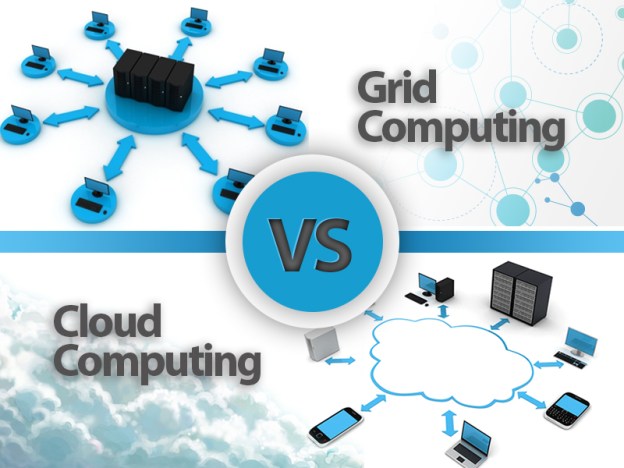
What are Cloud Computing and Grid Computing?
To better understand cloud computing vs grid computing differences, we really need to know the basic knowledge of these two technologies. Here introduces cloud computing and grid computing basics in simple terms:
Cloud computing can be defined as delivering computing services - servers, storage, databases, networking, software, and more - over the Internet, without having the physical computing resources at the customer location. This has decreased the hardware and software demand from the customer’s side. All the customer needs to do is to run the cloud computing systems interface software that is used as simple as the Web browser. Now there are public, private, and hybrid cloud computing that can be deployed. Fore more information about these three cloud, please read Popular ToR and ToR Switch in Data Center Architectures
As shown below, cloud computing consists of two components: front end and back end, which are connected together through the Internet. The front end is at the customer or computer side where end users interact with the cloud. The back end is the cloud section, which involves all the resources needed for providing cloud computing services. It often houses virtualized servers, data storage, virtual networks composed of various network switches, etc.

Cloud Computing Architecture
Grid computing is a loose distributed network of massive computers that can be called to perform dedicated tasks together, allowing each computer to run its independent tasks. Therefore it can solve problems that are too big for a supercomputer and maintain the flexibility to process numerous smaller problems at the same time. In the grid computing network, each computer is connected by parallel nodes that form a computer cluster, which runs on an operating system, Linux or free software.
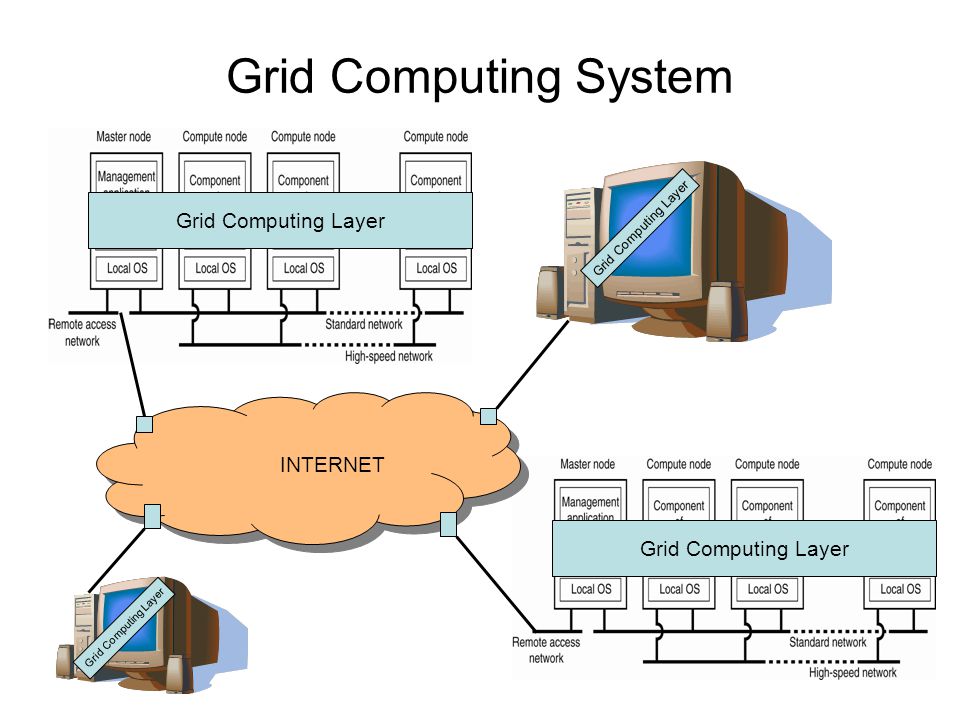
Grid Computing Architecture
Cloud Computing vs Grid Computing: What’s the Difference?
Seen from the above, the definition and architecture of cloud computing and grid computing are totally different, which further leads to differences on such aspects as functions, applications, etc. This following chart lists cloud computing vs grid computing differences in details for your reference:
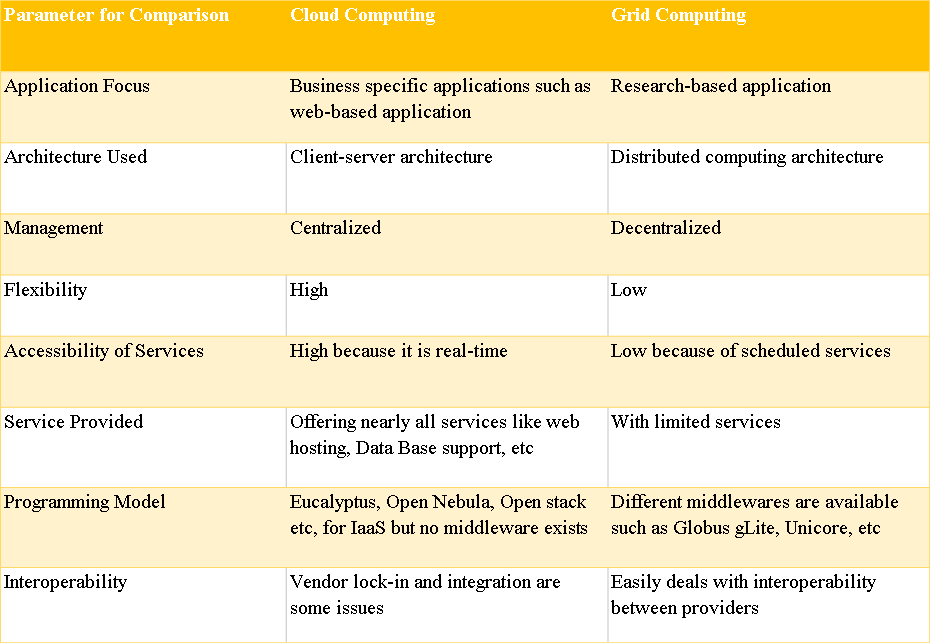
Cloud Computing vs Grid Computing, Which Do You Prefer?
Both cloud computing and grid computing are popular in the industry now, for they each has their own advantages and use cases. To conclude, cloud computing is ideal for applications where flexibility, ease-of-use and security are needed. Whereas grid computing is cheaper, more efficient and fail-safe. So cloud computing vs grid computing, which do you prefer? The answer really depends on what’s your need and how many resources you’ve got.
Originally published at http://www.fiber-optic-transceiver-module.com/cloud-computing-vs-grid-computing-difference.html
OpenvSwitch and OpenFlow: What Are They, What’s Their Relationship?
As software defined networking (SDN) becomes popular in high-bandwidth and dynamic applications (for example, cloud computing), related terms such as OpenvSwitch and OpenFlow are talked a lot by IT technicians. Though they have been introduced for a while, OpenvSwitch and OpenFlow still confuse people in some aspects. And the most frequently asked question is what’s the relationship and difference between OpenvSwitch and OpenFlow. Here we will cover these topics on what is OpenvSwitch, what is OpenFlow, and OpenvSwitch vs OpenFlow.
OpenvSwitch vs OpenFlow: OpenFlow Tutorial
Traditionally, networking hardwares from different vendors often have special configuration and management systems, which limits the interacting between routers and switches from different manufacturers. To solve this, OpenFlow is created as an open programmable network protocol for configuring and managing Gigabit network switches from various vendors. It enables us to offload the control plane of all the switches to a central controller and lets a central software define the behavior of the network. Thus network administrators can use OpenFlow software to manage and control traffic flow among different branded switching equipments.

How OpenFlow Works
OpenFlow generally consists of three components: OpenFlow controller, OpenFlow protocol and a chain of flow tables set up on the OpenFlow switch (as shown above). The OpenFlow protocol is like a media for the controller talking securely with OpenFlow switch. The OpenFlow controller can set rules about the data-forwarding behaviors of each forwarding device through the OpenFlow protocol. Flow tables installed on the switch often stores a collection of flow entries. So when a data packet arrives at the OpenFlow switch, the switch will search for matched flow entries in the flow tables and executes corresponding actions. If no match is found, an inquiry event will sent to the OpenFlow controller which then responds with a new flow entry for handling that queued packet.
OpenvSwitch vs OpenFlow: OpenvSwitch Tutorial
OpenvSwitch, sometimes abbreviated as OVS, is an open-source OpenFlow switch that works as a virtual switch in the virtualized environments such as KVM. It also used as a multilayer software for interconnecting virtual devices in the same host or between different hosts. Currently, OpenvSwitch can run on any Linux-based virtualization platform, which includes: KVM, VirtualBox, Xen, Xen Cloud Platform, XenServer.

OpenvSwitch Architecture
OpenvSwitch has eight core elements: ovs-vswitchd, Linux kernel module, ovsdb-server, ovs-dpctl, ovs-vsctl, ovs-appctl, ovs-ofctl, and ovs-pki. Ovs-vswitchd is a daemon that implements the switch. Linux kernel module is for flow-based switching. Ovsdb-server is a lightweight database server. Ovs-dpctl is a tool for configuring the switch kernel module. Ovs-vsctl is a utility for querying and updating the configuration of ovs-vswitchd. Ovs-appctl is a utility that sends commands to running Open vSwitch daemons. Ovs-ofctl is a utility for controlling the OpenFlow features of OVS. Ovs-pki is a utility for creating and managing the public-key infrastructure.
OpenvSwitch vs OpenFlow: What's Their Relationship?
OpenvSwitch and OpenFlow are both used for SDN application. OpenFlow is one of the first SDN standards. OpenvSwitch is an OpenStack SDN component. As to their relationship, OpenvSwitch is one of the most popular implementations of OpenFlow. Apart from OpenFlow, OpenvSwitch also supports other switch management protocols such as OVSDB (Open vSwitch Database Management Protocol).
Originally published at http://www.fiber-optic-transceiver-module.com/openvswitch-vs-openflow-what-are-they-whats-their-relationship.html
Rack Cable Manager for Data Center Cable Management
As plenty of devices and cables are added into data center cable racks, cable management in racks becomes one of the most pressing challenges for data center managers. To avoid rack cables looking like messy spaghetti, rack cable manager has long been an ideal solution to keep rack cables properly organized. But there are so many kinds of rack cable managers in the market, do you know which one to use for a specific situation? Here discusses some popular rack cable managers and their respective applications.
Cable Management Sections for A Rack
To better understand different kinds rack cable managers, we’d better to know the four cable management sections of a rack. Which are horizontal cable management, vertical cable management, inside of the rack cable management and top of the rack cable management. Horizontal cable managers and vertical cable managers are used for horizontal and vertical cable managements respectively, while copper/fiber patch panels and fiber raceway systems are for inside and top of the racks. The following parts will introduce various cable organizer for these four cable management sections.
Horizontal Rack Cable Manager
Horizontal rack cable manager is often used to manage cables in the front of racks and draw cables away from equipment neatly. It is usually one or two rack units high. Now there are many types of horizontal rack cable managers in the market, which are mainly divided into finger duct rack cable manager, D-ring horizontal cable manager and horizontal cable manager with brush strip. Among them, finger duct rack cable manager offers fingers and pass-through holes for routing rack cables and reducing cable strains, D-ring cable manager provides an “open” and efficient way to manage cables, brush strip manager is mainly used for allowing cables to be passed from the front to the rear of the rack. For more information on these three rack cable managers, read Selecting the Right Horizontal Cable Manager.

Horizontal Rack Cable Manager Types
Vertical Rack Cable Manager
Vertical rack cable managers are used for providing vertical pathways for cable bundles in the rack. Now the common types of vertical rack cable managers are D-ring vertical cable manager, vertical cable manager with bend radius fingers, and open frame rack vertical cable managers. The first one is a cost-effective solution for organizing and routing cable bundles. The second one is designed to maintain cable bend radius effectively. And the last one is available in single-sided and dual-sided models, which are specially used on the sides of open frame racks. For more information on these three rack cable managers, read Vertical Rack Cable Management: Where to Start?

Vertical Rack Cable Manager Types
Fiber Raceway System
Fiber raceway system is used to route and protect cables above racks. It consists of fiber raceway ducts, ladder racks, various interfaces, elbows and supports, etc. The fiber raceway duct often available in four sizes from 2"x 2" to 4" x 12". The following video shows how to set up a good fiber raceway system for top of the rack cable management:
Copper/Fiber Patch Panel
Copper/fiber patch panel is used to manage cables in the rack. It is often a board or enclosure which allows you to connect cables in various combinations with a number of copper/fiber sockets. Copper/fiber patch panel helps to keep things organized and contained, therefore cables in the rack won’t hang out all over the place. For more information about copper/fiber patch panel, read How to Use Fiber Patch Panel for Better Cable Management and How to Select the Suitable Copper Patch Panel?
Conclusion
Horizontal/vertical rack cable managers, fiber raceways and copper/fiber patch panels are good ways to manage and route your rack cables to sure everything is easy to access and identify. It is suggested to select proper rack cable managers according to your needs during set-up and installation of network cabling system.
Originally published at http://www.fiber-optic-transceiver-module.com/rack-cable-manager-for-data-center-cable-management.html
Cat6 Patch Panel: Shielded vs Unshielded
Patch panel is a commonly used mounted hardware assembly that contains ports for connecting and managing incoming and outgoing fiber/copper cables. It is usually attached to network racks, either above or below network switches. According to the cable type, it can be divided into Ethernet patch panel and fiber patch panel. Ethernet patch panel is for copper cable management while fiber patch panel is for fiber cabling. There are also shielded and unshielded Ethernet patch panels for different kinds of twisted pair cables. This post will focus on Cat6 patch panel shielded vs unshielded.
Cat6 Shielded Patch Panel
Cat6 shielded patch panel often consists of a metal panel and Cat6 snap-in shielded keystone jacks, which is perfect for high RFI/EMI environments where interference is a risk. It is often used together with shielded Cat6 cable which has better signal transmission performance. Based on the number of ports it contains, shielded Cat6 patch panel can be classified into 48-port, 24-port and 12-port types. The following image shows a 24 port shielded Cat6 patch panel which features installer-friendly design for quick installation and organization of shielded copper cabling system.
Cat6 Unshielded Patch Panel
Cat6 unshielded patch panel, on the other hand, is equipped with Cat6 snap-in unshielded keystone jacks. It is a more commonly used patch panel suited for most copper network systems. Like Cat6 shielded patch panel, unshielded Cat6 patch panel also has 48-port, 24-port and 12-port types. And the 24 port patch panel is the most popular one.
Cat6 Patch Panel: Shielded vs Unshielded
Cost—Cat6 shielded patch panel tends to cost more than the unshielded one. This is mainly due to more expensive Cat6 keystone jacks. And the use of Cat6 shielded cable will also add cost for the whole shielded cabling system.
Performance—Though the shielded Cat6 patch panel do cost more, it is better in helping to overcome alien crosstalk. In addition, it also provide such benefits as increasing immunity from outside electronic interference.
In practical applications, there often arises some questions such as can I use unshielded Cat6 cables on Cat6 shielded patch panels? Can I use shielded Cat6 cables with cat6 unshielded patch panels? Or can I use Cat5e cables on Cat6 patch panels? Here will discuss these questions in details:
Generally speaking, if you are setting up a network with Cat 6 shielded cables, you should use shielded Cat6 patch panels, which ensures the entire line stays fully shielded and helps to prevent data loss. This rule shall be strictly followed where cables will be run very close to other cables or electronic devices. In environments where the amount of EMI or RFI is low, it is feasible to connect unshielded Cat6 cables to cat6 shielded patch panels or use shielded Cat6 cables with cat6 unshielded patch panels. As to connecting Cat5e cables to Cat6 Patch Panel, electrically it will make contact and work fine, though the Cat5e cable is “looser” terminated on a Cat6 jack. But you should only expect Cat5e performance on the cat6 patch panel.
Conclusion
Cat6 patch panel is the most popular cable management tool for Gigabit Ethernet copper network. And shielded Cat6 patch panels are ideal for high-speed networks such as data center. While unshielded Cat6 patch panels are for most home or small enterprise network applications. FS.COM supplies cost-effective Cat6 patch panels, shielded or unshielded, feed-through or punch down are all available.
Originally published at http://www.fiber-optic-transceiver-module.com/cat6-patch-panel-shielded-vs-unshielded.html
EVPN vs VPLS: What Are They? What Are Their Differences?
EVPN and VPLS are two technologies that provide Ethernet multipoint services over IP/MPLS networks. And as everyone knows, VPLS has been available and widely deployed for many years. EVPN, however, is a new upcoming technology which is considered to be a more efficient and feasible alternative to VPLS. Even so, someone still configure VPLS on their networks and use it to good effect. Then what’s exactly the difference between EVPN and VPLS? Which one is better? This post will focus on EVPN and VPLS tutorials, and discuss EVPN vs VPLS differences.
EVPN vs VPLS: What Is VPLS?
VPLS, be short for virtual private LAN service, is a telecom carrier-provided service. It enables customer to create a logical LAN structure between geographically separate sites. Actually, VPLS creates a virtualized data switch at the service provider, which links multiple remote sites together as if they were connected to a same physical switch. This helps a lot in simplifying network deployment and management, especially for data center interconnection.

EVPN vs VPLS: What Is EVPN?
Like VPLS, EVPN also provides virtual multipoint bridged connectivity between different Layer 2 domains over IP/MPLS backbone network. it is typically composed of customer edge (CE) devices (host, router, or Gigabit Ethernet switch) and provider edge (PE) routers. The PE routers often include an MPLS edge switch (MES) such as a 10GbE switch, which acts at the edge of the MPLS infrastructure. The following is a typical EVPN deployment. Traffic from data center 1 is transported over the service provider’s network through MES1 to MES2 and then onto data center 2. DCS1, DCS2, DCS3, and DCS4 are the data center switches.

EVPN vs VPLS: What’s the Difference?
As mentioned above, EVPN is a more recent technology which aims to overcome the challenges VPLS meets. So it is more advanced in the following aspects:
VPLS features two kinds of signaling protocols: LDP and BGP. EVPN, however, adopts BGP as the only one service signaling protocol.
VPLS only implements single-active solutions. EVPN implements two CE multihoming solutions: single-active (one active, N standby) and all-active (with known uni-cast per-flow load balancing).
VPLS only supports data-plane MAC learning on its local Attachment Circuit (AC), which can easily lead to stale forwarding state. EVPN also performs data-plane MAC learning on its local AC, but it relies on control-plane MAC learning between PEs. This will reduce unknown uni-cast flooding and implement a flush mechanism in BGP.
Will EVPN Replace MPLS?
Though EVPN has much advantages than MPLS, it doesn’t mean it’s the best solution for everything. For example, VPLS is much less consuming in terms of control plane and it uses up more service MPLS labels than EVPN. In these circumstances, EVPN will not replace MPLS. EVPN vs VPLS, which will you choose for your network?
Originally published at http://www.fiber-optic-transceiver-module.com/evpn-vs-vpls-whats-the-difference.html
